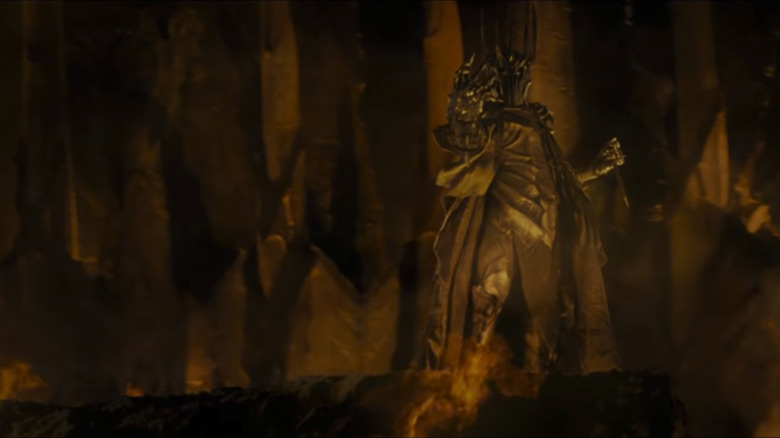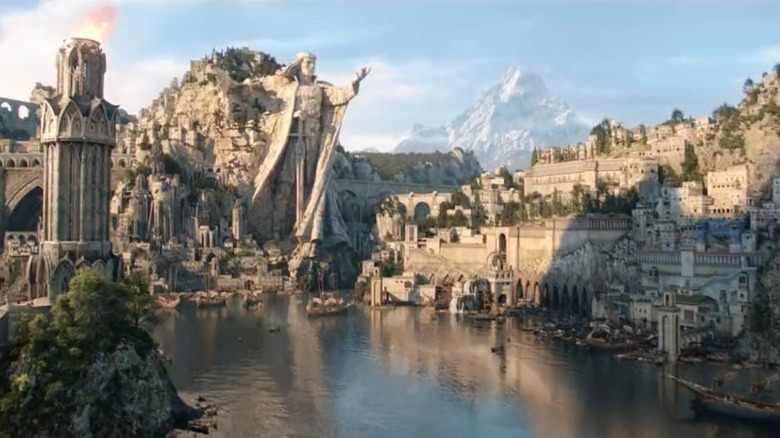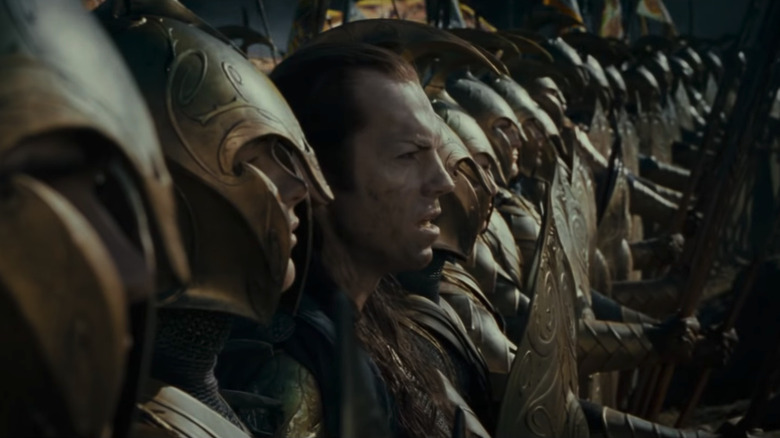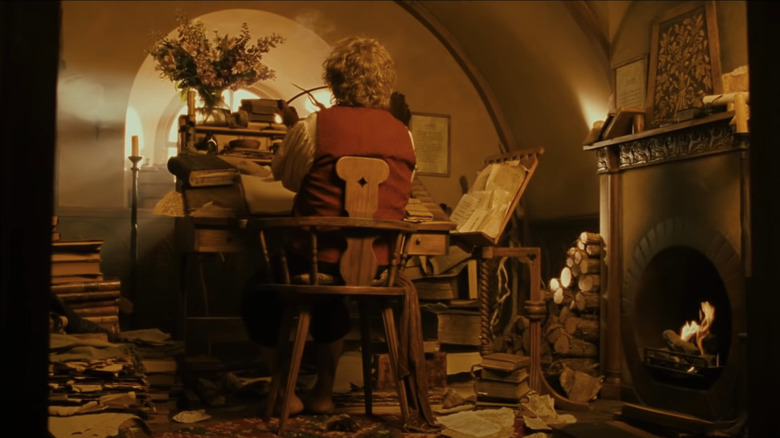The Tolkien Stories That Inspired The Lord Of The Rings: The Rings Of Power
Amazon's "Lord of the Rings: The Rings of Power" series is slowly coming into focus. After a rapid-fire release of character posters, behind-the-scenes interviews, and the show's first teaser trailer, fans are finally getting a serious glimpse into what Amazon Studios has been up to as its Middle-earth project has incubated over the past few years.
In a recent interview with Vanity Fair, series showrunners Patrick McKay and J.D. Payne officially clarified that they don't have the rights to any source material outside of "The Hobbit" and "The Lord of the Rings" trilogy (which does critically include the appendices of "The Return of the King"). Still, we're talking no "Silmarillion," no "Unfinished Tales," and no extracurricular Middle-earth stuff you'd expect they'd have available for a Second Age show.
Of course, that means the bulk of the content will need to be pulled from the appendices of "The Return of the King," which is still brimming with extra information about the eras that preceded the War of the Ring. In fact, in the same interview, the showrunners clarify that they'll be adapting several specific storylines from the Second Age into their condensed timeline for the show. McKay even went so far as to state: "We told Amazon we wanted to do four or five stories that are the big epics of the Second Age." Throughout the rest of the interview, they proceeded to highlight four of these storylines.
Here they are in the order that they're presented in Vanity Fair, along with a quick TL;DR summary for each one.
The forging of the Rings of Power
The first storyline that "The Rings of Power" will cover is the forging of the famed Rings of Power themselves.
When the era begins, the original Dark Lord, Morgoth, has just been overthrown, and his servants are in disarray. One of these is Morgoth's second-in-command, Sauron, who starts out hiding from his enemies in shame. Once he realizes that no one is actively chasing him, Sauron becomes bolder. He starts building his power in secret, sets up shop in Mordor, and begins dominating the Men of Middle-earth in various places.
Eventually, Sauron feels confident enough to brainstorm how he can take down the Elves, too, but they prove to be a harder nut to crack. He decides to pretend to be their friend, disguises himself as a pleasant fellow named "Annatar, Lord of Gifts," and tries to find some new Elvish pals. A group of Elves in Eregion are particularly intrigued by this Annatar guy — especially their leader, Celebrimbor, who is a famous craftsman. Annatar worms his way into the affections of Celebrimbor and his fellow smiths, a group of Elves called the Gawith-i-Mírdain. He teaches them to forge some magical rings, including 16 particularly powerful "Rings of Power."
Celebrimbor also uses his new knowledge to forge Three Elven Rings without Annatar, and of course, the Dark Lord in disguise eventually slinks back to Mordor where he quietly forges the One Ring to rule them all. It's a dramatic storyline and one that should serve as a good genesis for the story's narrative.
The rise of Sauron
The second major storyline that the show will incorporate is the rise of Sauron during the Second Age.
J.D. Payne points out that this will trace Sauron's story "when he was a physical villain" (via Vanity Fair). During this earlier period in Middle-earth history, Sauron is still very powerful and able to inhabit a humanoid body. In fact, he takes on many shapes during the First and Second Ages. When he embraces his new Annatar schtick in "The Silmarillion," it says that "his hue was still that of one both fair and wise." Along with this nicer appearance, toward the end of the age (but still during the time "The Rings of Power" is set in), it says that he takes on a new shape that is "terrible, for his fair semblance had departed for ever..."
Looks aside, Sauron's epic Second Age trajectory is insane. While he spends a lot of time beguiling the Elves, he also builds up his strength in Mordor. From there, he extends his influence over many of the surrounding tribes of Men, masses armies of different creatures, and becomes one of the most powerful forces on the mainland of Middle-earth. When he gets the 16 Rings of Power that he helped forge, he distributes them to Dwarves and Men, hoping to control them. This doesn't work with the Dwarves, but the Men become the Ringwraiths, which he uses with terrible effect.
This period of time is known as the Black Years, and they're summarized in "The Silmarillion" with the chilling line, "Now Sauron's lust and pride increased, until he knew no bounds, and he determined to make himself master of all things in Middle-earth, and to destroy the Elves, and to compass, if he might, the downfall of Númenor."
The rise and fall of Númenor
The island nation of Númenor is the ancestral home of the men of Gondor and its kings are the royal line that gives Aragorn his claim to the kingship in "The Lord of the Rings." However, Tolkien didn't just make up a convenient nation of men as a way to move his story forward. He fleshed out the background and history of the island until it became an epic in its own right — an epic that will form a central story pillar for the show.
The rise of Númenor starts with the beginning of the Second Age and basically follows a long, slow, and steady development of the most powerful nation of Men that Tolkien ever created. Sheltered on their own private island (given to them as a gift from the angelic Valar), Númenor becomes so powerful that even Sauron is afraid of its potential to interfere with his domineering plans.
However, the downfall of the Númenóreans is where the story really becomes juicy. At one point, Sauron's armies abandon him when faced with the overwhelming might of the Men of Númenor, and the Dark Lord pretends to surrender to his enemies. They take him back to their island, where he slowly works his way from their captive to the chief counselor of their corrupt king. This gives him the power to persecute anyone who is a friend of the Elves. He eventually convinces the king to attack the Valar themselves — an act that leads to the Atlantis-like destruction of his entire kingdom. The few survivors of the apocalyptic event sail to mainland Middle-earth where they set up the kingdoms of Gondor and Arnor, setting the stage for the fourth storyline in the process.
The Last Alliance of Elves and Men
The last story that the showrunners give us is the tale of the War of the Last Alliance. This is where the story of "The Rings of Power" will officially connect to Peter Jackson's trilogies. The Last Alliance narrative ends with the attack on Sauron as seen in the opening scene of "The Fellowship of the Ring."
However, a lot of things have to happen beforehand in order for those events to take place, and it starts with the founding of Gondor and Arnor after Númenor sinks. The two new kingdoms are founded by an offshoot of the Númenórean royal family led by Elendil, who becomes the High King in Arnor while his sons, Isildur and Anárion, rule in Gondor. At first, they think that Sauron has disappeared along with their homeland, but soon it becomes clear that the Dark Lord is back — right next door to Gondor in his old haunt, Mordor.
Eventually, Sauron gathers up enough of his servants to unleash a new war, and Isildur heads north to ask for help from his father and his dad's new best bud, Gil-galad, the Elven king of the land of Lindon. The pair decides to found the Last Alliance and send out word for all of the Free Peoples of Middle-earth to join them in a final attack on Sauron. They gather their strength for a few years and then, get this, they invade Mordor. There's a massive battle outside of the Black Gates in the area that later becomes known as the Dead Marshes. Only after this, do the good guys force their way into Mordor and defeat Sauron, setting things up for the Third Age that follows.
Bringing Tolkien's stories together
"The Rings of Power" is taking a huge gamble by trying to weave all of these stories into a single storyline that takes place all at once. In Tolkien's works, they are drawn out over the course of more than three thousand years. This was one of the biggest challenges that fans knew had to be overcome in an on-screen adaptation of the source material, and condensing the timeline turns out to be the self-admittedly biggest deviation from the text that the show is making.
However, the showrunners have defended this decision by telling Vanity Fair, "If you are true to the exact letter of the law, you are going to be telling a story in which your human characters are dying off every season because you're jumping 200 years in time, and then you're not meeting really big, important canon characters until season four."
It's an understandable dilemma, albeit one that many diehard fans have used as a primary reason why this content should never be adapted to an on-screen format in the first place. With that said, it will be fascinating to watch as Patrick McKay, J.D. Payne, and the entire production crew strive to condense Tolkien's Second Age into a cohesive narrative that takes place in a single point in time.
One thing is certain already, though. Even if their source material is limited, they have a gosh darn lot of stuff to fit into this thing.





